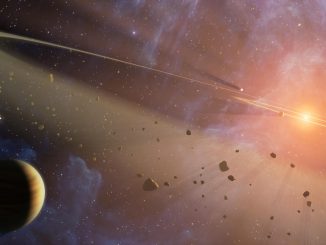Firing off a string of snapshots like a sports photographer at a NASCAR race, NASA’s Hubble Space Telescope captured a rare look at three of Jupiter’s largest moons parading across the banded face of the gas-giant planet: Europa, Callisto, and Io.
The Hubble image on the left (unlabelled at top left, labelled at bottom left) shows the beginning of the event, which took place on 24th January 2015. From left to right the moons Callisto and Io are above Jupiter’s cloud tops. The shadows from Europa (not seen in the image), Callisto, and Io are strung out from left to right.
Near the end of the event, approximately 42 minutes later (right-side image), Europa has entered the frame at lower left. Slower-moving Callisto is above and to the right of Europa. Fastest-moving Io is approaching the eastern limb of the planet; its shadow is no longer visible on Jupiter. Europa’s shadow is toward the left side of the image, and Callisto’s shadow to the right. (The moons’ orbital velocities are proportionally slower with increasing distance from the planet.)
Missing from the sequence is the moon Ganymede, which was outside Hubble’s field of view and too far from Jupiter in angular separation to be considered part of the conjunction.
The moons in these photos have distinctive colours. The ancient, cratered surface of Callisto is brownish; the smooth icy surface of Europa is yellow-white; and the volcanic, sulfur-dioxide surface of Io is orange. The apparent “fuzziness” of some of the shadows depends on the moons’ distances from Jupiter. The farther away a moon is from the planet, the softer the shadow, because the shadow is more spread out across the disc.



